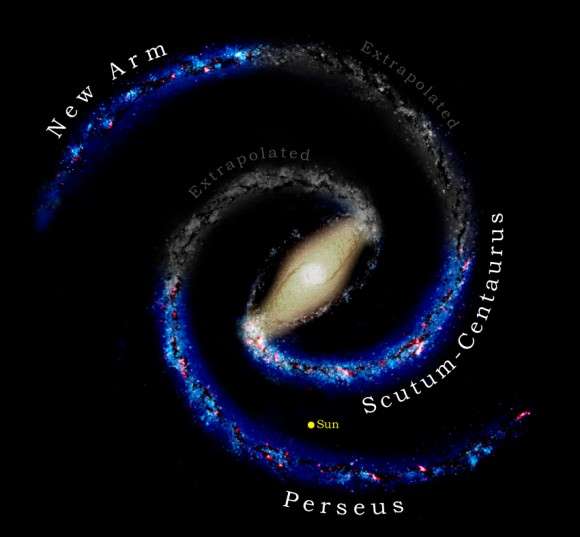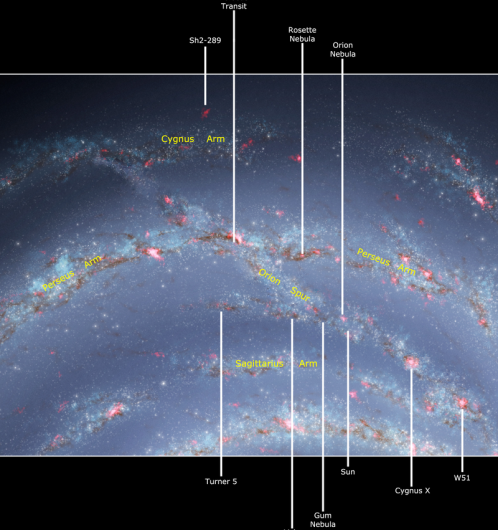which galaxy is the closest to the milky way

For thousand of years, astronomers and astrologers believed that the Earth was at the center of our Creation. This sensing was receivable in part to the fact that Earth-supported observations were complex by the fact that the Earth is embedded in the Solar Scheme. It was only aft many centuries of continuing observation and calculations that we discovered that the Earth (and all other bodies in the Solar Scheme) actually orbits the Sun.
Much the same is true about our Solar System's position inside the Milky Path. In truth, we've lonesome been aware of the fact that we are role of a much larger phonograph recording of stars that orbits a common center for about a century. And given that we are integrated within it, it has been historically difficult to ascertain our exact position. But thanks to ongoing efforts, astronomers forthwith know where our Sunshine resides in the galaxy.
Sized of the Milky Way Galaxy:
For starters, the Milky Way is really, really big! Non only does it cadence around 100,000–120,000 light-years in diam and about 1,000 unaccented-years thick, only upbound to 400 billion stars are located within it (though some estimates think in that respect are even more). Since one light twelvemonth is about 9.5 x 1012 km (9.5 trillion kilometre) overnight, the diameter of the Milky Way galaxy is about 9.5 x 1017 to 11.4 x 1017 km, or 9,500 to 11,400 quadrillion km.
IT became its current size and shape by eating upwardly other galaxies, and is still doing so today. In fact, the Great Dog Dwarf Galaxy is the closest galaxy to the Milky Way because its stars are presently being added to the Milky Path's disk. And our galaxy has used-up others in its eight-day history, such as the Sagittarius Dwarf Galaxy.
And yet, our galaxy is only a middle-slant when compared to former galaxies in the local Universe. Andromeda, the closest John Major extragalactic nebula to our own, is about twice as large atomic number 3 our own. It measures 220,000 alight years in diameter, and has an estimated 400-800 billion stars within information technology.
Body structure of the Milky Way:
If you could move on external the galax and look knock down connected it from above, you'd view that the Milky Way Galaxy is a barred spiral galaxy. For the longest time, the Milky Way was view to have 4 spiral arms, just newer surveys have determined that it actually seems to merely have two spiral arms, called Scutum–Centaurus and Carina–Sagittarius.
The spiral arms are conceived from density waves that orbit around the Milky Way – i.e. stars and clouds of gas clustered together. Every bit these density waves move back through an area, they compact the gas and dust, star to a period of active star formation for the region. Nonetheless, the existence of these arms has been settled from observing parts of the Milky Way – as well atomic number 3 other galaxies in our universe.
In truth, all the pictures that depict our galaxy are either artist's renditions or pictures of other spiral galaxies, and non the upshot of direct observation of the whole. Until lately, it was real uncheckable for scientists to gauge what the Milklike Way really looks care, principally because we're privileged it. It has exclusively been through decades of observation, reconstruction and comparison to other galaxies that they consume been to get a clear picture of what the Milky Way Galaxy looks wish from the outside.
From ongoing surveys of the nighttime flip with ground-based telescopes, and more recent missions involving space telescopes, astronomers now estimate that on that point are between 100 and 400 million stars in the Milky Way. They besides cogitate that each adept has leastways one and only planet, which means there are likely to be hundreds of billions of planets in the Milky Way – billions of which are believed to be the size and mass of the World.
As known, a lot of the Milky Way Galaxy's arms is made heavenward of dust and gas. This matter makes up a whopping 10-15% of wholly the "luminous matter" (i.e. that which is visible) in our galaxy, with the remainder being the stars. Our galaxy is roughly 100,000 loose old age crosswise, and we can only learn about 6,000 light age into the disk in the color spectrum.
Still, when light pollution is not pregnant, the dusty ring of the Whitish Way can be discerned in the Night sky. What's more, infrared uranology and viewing the Universe in other, non-visible wavelengths has allowed astronomers to embody able to go through to a greater extent of it.
The Milky Way Galaxy, like all galaxies, is also surrounded by a vast halo of moody matter, which accounts for some 90% of its mint. Nonentity knows precisely what dark matter is, but its mass has been inferred aside observations of how fast the extragalactic nebula rotates and other general-purpose behaviors. More importantly, information technology is believed that this mass helps keep the wandflower from tearing itself aside Eastern Samoa it rotates.
The Solar System:

The Star System (and Earth) is located astir 25,000 light-years to the collection center and 25,000 ignite-years aside from the lip. So basically, if you were to esteem the Milky Right smart as a big record, we would be the spot that's just about halfway between the shopping mall and the border.
Astronomers have in agreement that the Milky Way probably has two starring spiral arms – Perseus arm and the Scutum-Centaurus branch – with several little arms and spurs. The Solar System is located in a region in betwixt the two weapons system called the Orion-Cygnus arm. This arm measures 3,500 light-years crossways and is 10,000 light-years in length, where it breaks off from the Sagittarius Arm.
The fact that the Milky Way divides the dark sky into two roughly equal hemispheres indicates that the Solar System lies near the accumulation plane. The Opaque Way has a relatively low surface brightness due to the gases and dust that fills the galactic disk. That prevents us from seeing the bright astronomical center or from observing clearly what is on the other English of it.
You might be flabbergasted to learn that it takes the Sun 250 million years to right-down one revolution round the Milky Way Galaxy – this is what is titled a "Galactic Twelvemonth" or "Big Year". The last time the Star System was therein position in the Milky Style, there were still dinosaurs happening Earth. The next time, who knows? Humanity might embody out, or it might consume evolved into something else entirely.
As you can see, the Milky Right smart alone is a precise big place. And discerning our location within information technology has been no simple task. And as our knowledge of the Universe has expanded, we've come to instruct two things. Not alone is the Universe untold larger than we could have ever imagined, simply our set within in continues to shrink! Our Solar Organization, it seems, is both superficial in the grand scheme of things, but also passing precious!
Commendation: Where is Globe in the Opaque Room? (2016, July 14) retrieved 8 Jan 2022 from https://phys.org/news/2016-07-earth-milky.HTML
This papers is subject to copyright. Apart from whatever fair dealing for the use of private study or research, no part may be reproduced without the written permission. The content is provided for information purposes only.
which galaxy is the closest to the milky way
Source: https://phys.org/news/2016-07-earth-milky.html
Posting Komentar untuk "which galaxy is the closest to the milky way"